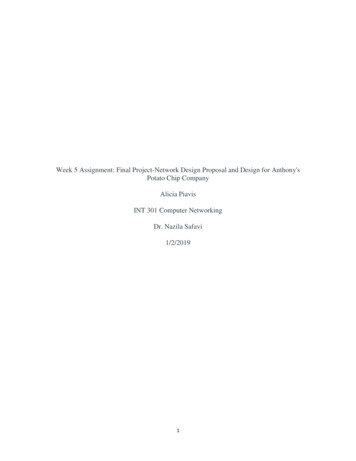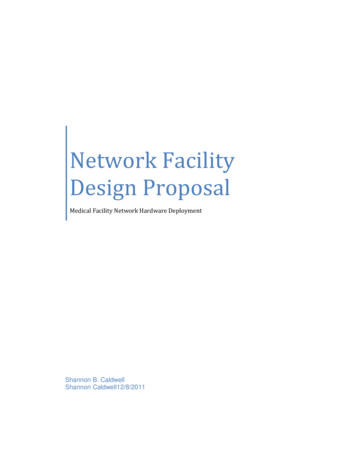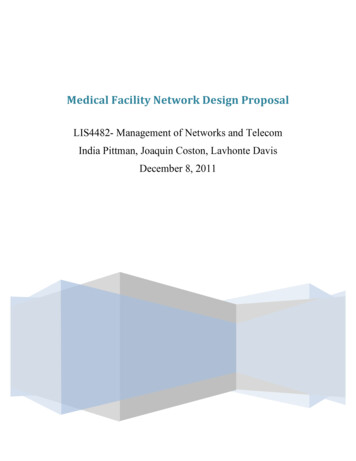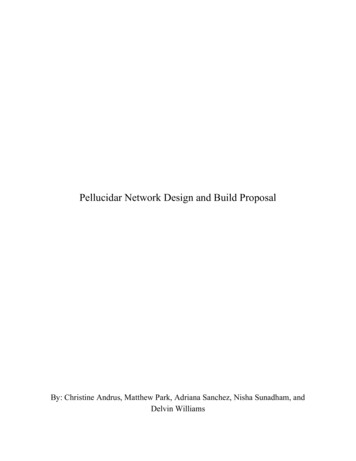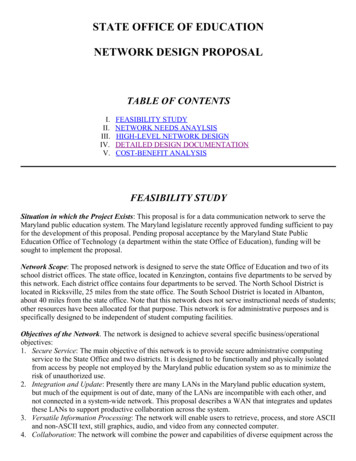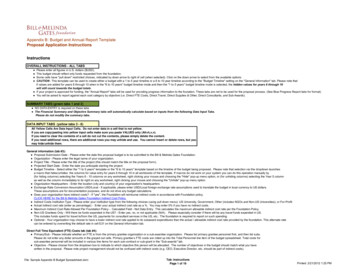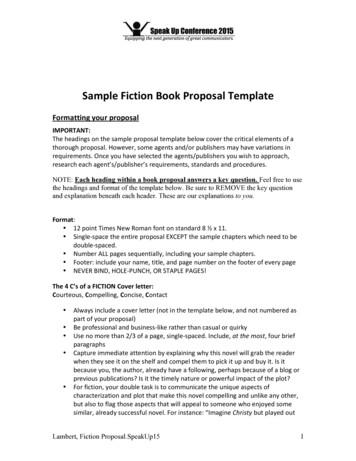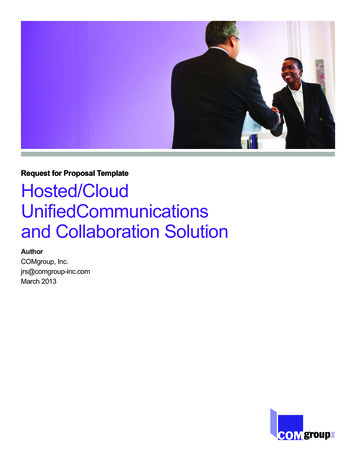
Transcription
N E T WOR K D E S IG NP ROP OS A LPREPARED FOR ABC CORPORATIONPrepared byCrystal TechnologiesP R OP R IE TAR Y A N D CO NF IDE N TIAL
Network Design ProposalPREPARED FOR ABC CORPORATION INC.A R T I C LE I .OVE RVI EW / H I STORYIn the January 2009 account review, Crystal presented to ABC Corporation a network designthat included visios and recommendations focused on replacing ABC Corporation’s existing back-upFrame Relay network with a back-up MPLS network that could be utilized for more than networkfailover in the event of an outage. This “secondary” network would be capable of offloading existingdata requirements and also have the flexibility to accommodate future growth and changes.In the May 2009 account review, Crystal highlighted the January network recommendations andalso addressed more current needs, such as bandwidth saturation and expansion of videorequirements, with additional recommendations. The fundamental of the basic recommendedsolution, however remained intact.The purpose of this document is to define the requirements, considerations, and overall designspecifications so that vendors can be selected to provide the appropriate solutions.A R T I C LE I I .B U SI N E SS R E QU I RE M E NT S A ND C O N SI D ER A TI O N S1. MPLS secondary network that will back up the primary Qwest WAN at all locations thathave five or more employees.2. Utilize single router for both primary and secondary networks at remote locations.3. Solution that will provide Internet access for guests, that is separate from ABCCorporation’s production network(s).4. Solution that will accommodate the bandwidth and priority required for data replicationtraffic between Pennsylvania and North Carolina that will not interrupt other productiontraffic.5. Accommodate future growth in VoIP traffic on WAN.6. Prioritization of Tier 1 and Tier 2 applications such as ERP, Email, and Time tracking.CR SY T AL TE C H NOLO GIE S P R OP R IE TAR Y A N D CO NF IDE NTI AL2
7. Solution that will satisfy existing video requirements and be flexible enough to providefor future growth in use of video calls.8. Provide flexibility to distribute secure access to the internet from more than the threeexisting locations (Pennsylvania, NY, North Carolina) without adding firewall hardware.9. Support content filtering as a cloud computing application.10. Support Distributed File System (DFS) initiative.A R T I C LE I I I . SO L U TI O N SUM M ARYCrystal believes that the solution shared in this document will satisfy all of the businessrequirements and considerations of ABC Corporation, as well as provide necessary flexibility fortoday’s rapidly changing business environment.Crystal proposes the installation of a secondary MPLS network that will back up the primaryQwest Network. This secondary network will be capable of the following in addition to basic IPWAN connectivity and the ability to back up the Qwest WAN:1. Capability to permit secure access to the internet from the carrier’s cloud.2. Capability to provide local dial-tone over IP.3. Prioritization of any applications and traffic shaping through COS/QOSSince a decision has been made that a back-up network is necessary, Crystal recommends thatthis network not sit idle waiting for a network failure, but also be used as a primary route forInternet browsing and video traffic. The two networks will essentially share the traffic loadsaccording to traffic type and back each other up in case of a failure.CR SY T AL TE C H NOLO GIE S P R OP R IE TAR Y A N D CO NF IDE NTI AL3
A R T I C LE I V. N E TWOR K SO L U TI O N D E TA I L SPRIMARY WAN NETWORKThe primary network will remain on Qwest with relevant changes to port size that are detailed inseparate bandwidth analysis.1. Network gear – all existing routers and switches will be able to be used2. Traffic types – This network will be the primary path for :a. Voice payloads – Interoffice Siemens Calls and Siemens VMailb. Voice Call Control – Call set up for above payloadsc. Business Data applications- ERP, Time Tracking, DFS, file/print sharing,Active Directory traffic, etc. At this time we recommend that DFS traffic berouted on this network due to the complications that could be encounteredtrying to route, this traffic differently than other windows traffic.3. COS/QOS – Qwest uses IPP for queuing. Class maps are needed to map DSCP valuesand/or specific applications to IPP values. Most of this is already in place on the router.The Queues will be prioritized as followsa. Queue 1 - Voice Payloadsb. Queue 2 - Voice Call Control, Videoc. Queue 3 - Critical data applications such as ERP, Time Tracking, etc.d. Queue 4 – All remaining traffic would be best effortA specific location may or may not require all 4 Classes of Service.4. Routing – The BGP routing protocol is needed and is already in place to maintainappropriate routing tables. Video and Voice need to be in a separate VLAN and Subnet.Cisco 4500 switches in NY, Pennsylvania, will also need to support BGP; these switcheswill become the core routers at their respective locations. North Carolina will need tohave a Layer 3 switch that can support BGP.CR SY T AL TE C H NOLO GIE S P R OP R IE TAR Y A N D CO NF IDE NTI AL4
VoIP traffic and user-server data traffic will have this network configured as thepreferred route, and the Carrier X network will be weighted as the less-preferred route.The Qwest network cloud will continue to route traffic to Pennsylvania as the defaultroute.SECONDARY WAN NETWORKCarrier X will be selected to provide the secondary MPLS network. This MPLS networkmust be capable of providing secure internet access from the carrier cloud as well asproviding local dial-tone using SIP trunks.1. Network gear – This WAN will terminate into existing routers at the remote locationsand into their own routers at the host locations that have a layer 3 switch (NY,Pennsylvania, and North Carolina)a. Remote Locations - The routers at these locations will need an additional WICcard(s) added to support the T1s for the secondary WAN. The existing routerswill be able to support 4 T1’s total between the primary and secondarynetworks. Additional bandwidth requirements at an individual location that arein excess of these 4 T1’s will require replacing the existing router or adding anew router and layer 3 switch.b. Remote locations with integrated Voice – For locations that require anintegrated voice solution, these routers may require additional hardwaredepending upon the capabilities and SIP hand-off qualifications of the existingPBX systems.1) PBX system qualified for SIP trunks with Carrier X – an existingunused Ethernet port on the router can be used to hand the SIP trunksto the PBX. The PBX must be pre-qualified with Carrier X for thisfunctionalityc. Host Locations – New 2845 or 3825 routers will be required at these locationsto support the bandwidth requirements of the new secondary network.2. Traffic types – This network will be the primary path for :a. Video – All Video Conferencing CallsCR SY T AL TE C H NOLO GIE S P R OP R IE TAR Y A N D CO NF IDE NTI AL5
b. Internet browsing traffic.3. COS/QOS – The COS configuration on this network will mirror the primary networkat an appropriate scale. Router configurations will be required to treat and/or maptraffic to the appropriate queue according to Carrier X’s Queuing method.4. Routing – Carrier X will need to support both BGP and Static routing to supportautomatic failover and fail-back between the two networks.The Video subnets will have the Carrier X networks configured as the preferred route. TheQwest network will be weighted as a less preferred route for video. We recommend thatcompany policy dictate that video conferencing not be used during an outage situation. If itbecomes necessary, the COS configuration will be in place to support video.The preferred default route for internet browsing will be the Carrier X network. The Qwestnetwork will be weighted as the less preferred route of last choice, sending internet traffic toPennsylvania if the local Carrier X MPLS network fails.GUEST INTERNET ACCESSAll sites that require guest internet access should have a broadband DSL, cable, or FIOSproduct. This will be a completely separate physical network that is not connected to theproduction subnets. A SOHO router/firewall appliance such as the Linksys R082 should bedeployed.DISASTER RECOVERY DATA REPLICATIONABC Corporation is currently using a Data Replication application to replicate critical dataand application servers from Pennsylvania to North Carolina. North Carolina will serve as aDR site.Crystal recommends that this traffic be placed on its own dedicated circuit path using CarrierY, per best practices for DR considerations. The cost of a private line would be prohibitivecompared to a separate IP network that will be more than sufficient. COS will not berequired. This accomplishes the following:1. Maintains an N 1 ratio of network circuit paths to sites for the 2 host locations.2. Eliminates any contention for bandwidth on the two existing network paths3. Reduces possibility for contention with prioritization of packets within a specifiedQOS queues.CR SY T AL TE C H NOLO GIE S P R OP R IE TAR Y A N D CO NF IDE NTI AL6
This design would include new routers at Pennsylvania and North Carolina for this separateIP Network.In addition to a separate WAN for this replication process Crystal also recommends that aseparate LAN be considered for this as well. The participating servers and SAN systemsshould be multi-homed for both the production LAN and the replication LAN. Thissolution will take a considerable amount of load off of the existing production LAN.Note:As an alternative to the Carrier Y solution for this requirement, Crystal also recommendsthat separate PVCS – CUGS be defined on the Qwest enhanced DS3 ports at NorthCarolina and Pennsylvania. This accomplishes all of the same objectives including N 1circuit paths, however without N 1 carriers.VOIP GROWTHThis design fully accounts for future growth with the existing VoIP applications as well asfuture considerations of alternative and/or complimentary solutions.1. Existing VoIP applications – The Siemens solution is currently using VoIP forinteroffice calls and vmail between LA, California, Pittsburgh, and Philadelphia.a. Solution provides for flexibility to grow Siemens or an alternative network onexisting Qwest WAN through adding bandwidth and QOS, when and where itis needed.b. Design calls for mapping all voice payloads to the top priority Queue in boththe Qwest primary network and Carrier X back-up network in case of failure.2. Future VoIP applicationsa. Introduction of one or more additional IP PBX solutions can be fullysupported through the Qwest and/or Carrier X WAN.b. Carrier X will fully be able to support SIP trunks to provide local and LDcalling over the MPLS connection. Qwest also now has this functionalityfor LD and is road mapped for local availability. SIP trunks do require apre-qualification process for each PBXc. Both Qwest and some Carrier X candidates offer hosted PBX solutions.These solutions are only supported on their native networks, however 3rdCR SY T AL TE C H NOLO GIE S P R OP R IE TAR Y A N D CO NF IDE NTI AL7
Party PBX Hosting Services are available that are carrier independent, andcould be supported successfully on this design.PRIORITIZATION OF CRITICAL BUSINESS APPLICATIONSBoth Qwest and Carrier X will support COS for critical business applications in a 2 nd, 3rd, or4t Queue as needed. Some of the Carrier X candidates support more than 4 Queues,however we believe that ABC Corporation only needs 4, especially with the design to movereplication to another network.We recommend setting both the primary and secondary network up with mirroredCOS/QOS configurations that are scaled to the appropriate bandwidth. This design willensure maximum quality assurance of data prioritization in event of a network failure thatcauses a re-route of traffic.SUPPORT EXISTING VIDEO REQUIREMENTS AND PROMOTE FUTURE GROWTHThis design calls for the placing of Video into the 2nd Queue on the Carrier X network. Thiswill provide video calls top priority over internet traffic, and will only be trumped by VoIPcalls if applicable.The Qwest network can be configured with a mirrored QOS configuration for Video in caseof a Carrier X failure, but at this time we recommend that corporate policy dictate that novideo calls are permitted during an outage.Additional growth will only require appropriate bandwidth and setting QOS parameters.Secure Distributed Local InternetThe current configuration has NY, Pennsylvania and North Carolina with direct localinternet access secured by premise based firewalls. All remote sites access the internetthrough the Pennsylvania internet connection, and are secured through that firewall.This design proposes that each site access the internet locally. This will accomplish thefollowing:CR SY T AL TE C H NOLO GIE S P R OP R IE TAR Y A N D CO NF IDE NTI AL8
1. Reduce internet latency for roundtrips across the country2. Alleviate periodic congestion at Pennsylvania Qwest WAN port that is partly causedby Internet traffic to and from remotes.The specifics of this design are as follows:1. NY, Pennsylvania, and North Carolina will continue to access the internet fromtheir local internet connection and be secured by the local firewall. These locationswill handle all inbound traffic for all application server that need to receive trafficfrom the public domain such as mail, web servers, employee and client VPNconnections, etc.2. Remote sites will access the internet locally using their Carrier X MPLS trunk thatwill have a gateway to the internet that is secured by a network-based firewall in thecloud. This internet access will only be used for web based traffic such as internetbrowsing or web based applications hosted in the public domain. No trafficoriginated in the public domain will b
Network Design Proposal PREPARED FOR ABC CORPORATION INC. ARTICLE I. OVERVIEW/HISTORY In the January 2009 account review, Crystal presented to ABC Corporation a network design that included visios and recommendations focused
